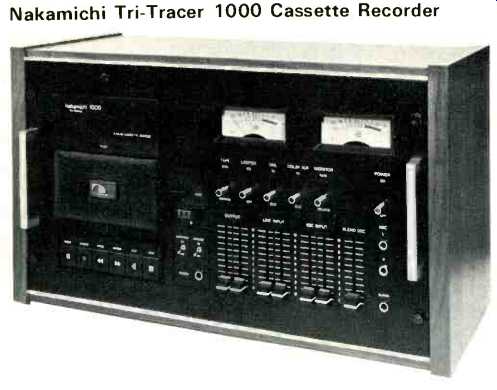
MANUFACTURER'S SPECIFICATIONS
Wow and Flutter: Less than 0.10% (DIN).
Frequency Response: 35 to 18,000 Hz ± 3 dB, Low Noise Tape; 35 to 20,000 Hz ± 3 dB, CrO2 tape (both using Dolby).
Signal-to Noise: Better than 60 dB (DIN), Dolby, weighted at 3% distortion.
Total Harmonic Distortion: Less than 2%, 0 VU, 1 kHz.
Channel Separation: Better than 35 dB, 0 VU, 1 kHz.
Bias Frequency: 105 kHz.
Headphone Output: 3 mW.
Dimensions: 20.7 in. W x 11.7 in. H x 8.6 in. D.
Price: $1,100.00.
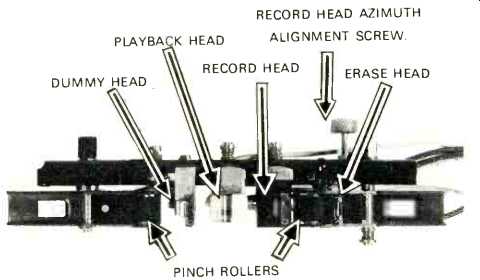
Fig. 1--Head configuration.
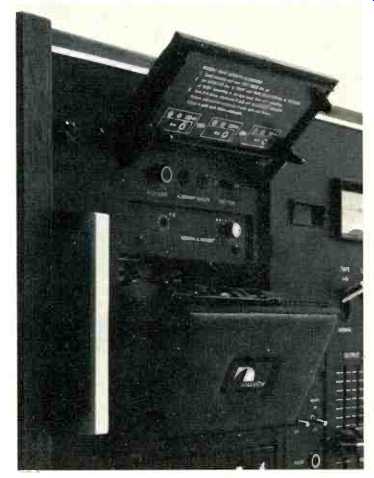
Fig. 2--Showing compartment containing speed and head alignment controls.
The Nakamichi 1000 must surely be considered the Rolls Royce of cassette recorders with its two noise reduction systems (Dolby and Philips DNL), variable speed, separate record head with monitoring facilities, IC logic control, and a host of other features. It is intended for professional users but it will obviously appeal to many enthusiasts who want state-of-the-art performance-and can afford the $1100! The unit is housed in a wooden case for vertical operation but it is available for rack mounting if desired. At the left is the cassette compartment and just above that is a hinged door covering the speed control and head alignment controls (see Fig. 2). Adjustment is simplicity itself and it works like this: A built-in oscillator or generator supplies a 400 Hz signal which is recorded on the tape. Output from the recording and playback heads is taken via a phase-comparison amplifier to two LED indicator lamps called alignment beacons. All the user has to do is turn an adjustment control so that the lights are balanced. The control affects only the record head. In other words, it is matched to the playback head which is aligned at the factory. There is an azimuth adjustment for this head and it can be checked with a standard test tape if necessary. Incidentally, tape motion is from right to left and the heads are mounted above the tape. The tape speed control gives a variation of ± 6% in playback only and it is labeled PITCH CONTROL. Under the cassette compartment are six touch-control buttons labeled PAUSE, RECORD, F. FORWARD. REWIND, STOP, and PLAY and each one has an indicator light. To the right of these controls is a small panel on which is mounted the tape counter, EJECT button, AUTO REW and MEMORY rewind switches plus a headphone jack. The MEMORY rewind switch allows the tape to be wound back to a preset point and the AUTO REW switch will automatically ensure that the tape will be rewound at the end of the tape-a useful device! At the top right are the two large VU meters (peak reading), and underneath them are switches for TAPE SELECTION ( NORMAL and CrO2), LIMITER. DOLBY and DNL noise reduction and tape-source MONITOR. To the right is the ON/OFF switch and three MIC INPUT sockets-one for each channel and one for center, or BLEND. To the left of these
are twin slide controls for OUTPUT, LINE INPUT, and MIC INPUT and a single one for the BLEND mic position. Finally, at the top center is an illuminated tape run indicator. At the rear are the input and output sockets, test-tone level control and calibration controls for both CrO2 and NORMAL tapes. There are also two DIN sockets (one for stereo mic) and an MPX switch that cuts response above 18 kHz to prevent the FM 19 kHz carrier from interfering with Dolby operation and-I almost forgot-a socket for a remote control unit.
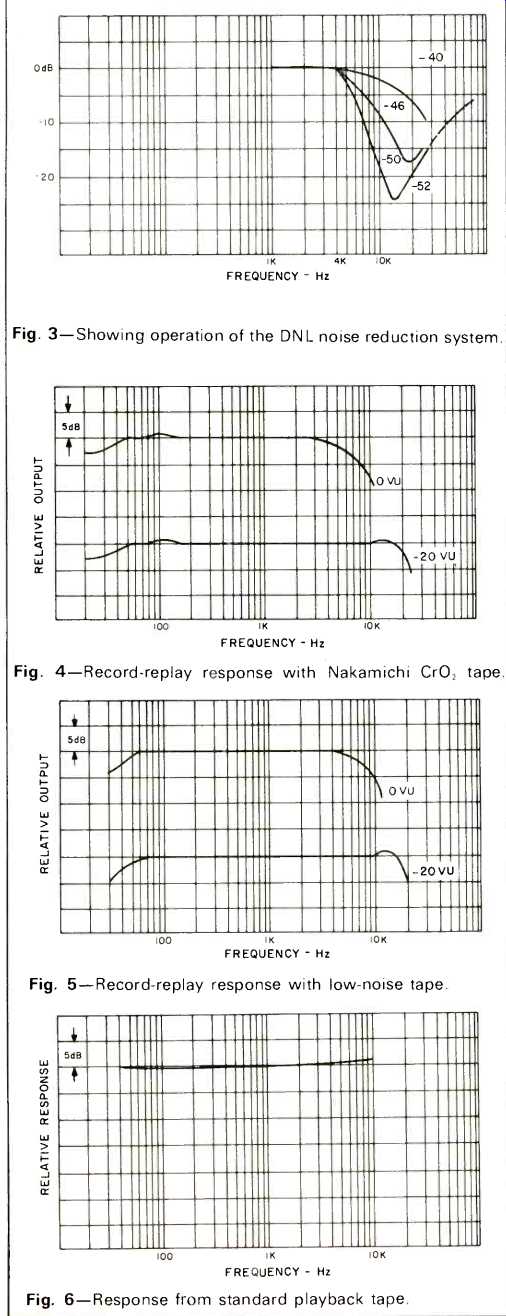
Fig. 3-Showing operation of the DNL noise reduction system.
Fig. 4-Record-replay response with Nakamichi CrO2 tape.
Fig. 5-Record-replay response with low-noise tape
Fig. 6-Response from standard playback tape.
Model 1000 employs no less than 138 transistors, 59 diodes and 8 ICs. A very complex logic circuit is used for precise control to ensure foolproof, effortless operation and freedom from click noise. Thus, if you want to record when the machine is in the STOP position, you press (or rather touch)
the appropriate buttons and the sequence of events is as follows: First the bias oscillator is switched on, then after 100 milliseconds the head moves to position and the pinch roller starts to rotate. When the tape movement is stable (520 mS), the record amplifier is turned on and is ready after 70 mS. Finally, after 790 mS the playback amplifier is turned on. When recording stops, first the recording amplifier is switched off, then the bias oscillator slowly "dies" and the playback amplifier is switched off-the whole sequence taking 200 mS.
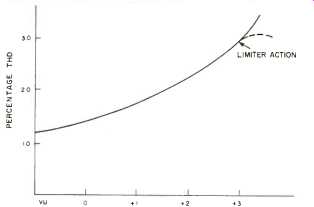
Fig. 7--Distortion at 1 kHz. Dotted line shows limiter action.
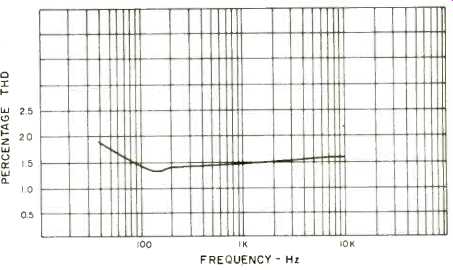
Fig. 8--Distortion versus frequency.
As mentioned above, two noise reduction systems, Dolby B and Philips DNL, are used and it might be thought that this is really gilding the lily or at least extravagant. However, a moment's thought will show that these two systems are not incompatible but actually are complementary. As most readers know, the Dolby system functions by boosting high frequency signals during recording and then reducing them at playback (A simplified explanation, but it will suffice). Now, the DNL is rather different in that it works only during playback.
Frequencies above 4 kHz are cut in proportion to level as shown in Fig. 3. Note that the maximum effect is in the region of 10 kHz and that the system has virtually no effect above levels of-40 dB. So the DNL system can be used on playback with ordinary tapes and the Dolby reserved for recording. Can you use both together? The answer is yes, and the total noise reduction is then about 13 dB. For most purposes, it is probably better to use them separately as suggested.
The main play-transport motor is a servo-controlled phonic wheel d.c. type and a double capstan is used with staggered heavy flywheels. A second motor handles fast forward and rewind. Because there are separate record and playback heads, each can be designed for optimum results. Thus, the gap in the record head is 5 microns but the playback head has an exceptionally small gap of only 0.7 microns! This enables the high-frequency response to be maintained up to 20 kHz or so, but it does mean that care must be taken to keep the heads clean and aligned properly. Figure 4 shows the record-replay response from the Nakamichi CrO2 tape supplied, and Fig. 5 shows the response with low-noise tape, also Nakamichi. The chromium dioxide tape has a wider response (3 dB point at 21 kHz against 19 kHz) but the difference in practice is small.
Incidentally, the tape selector switch is marked CrO2 and NORMAL, but in this instance NORMAL refers to low-noise tapes like TDK SD or Maxell UD and so on. Figure 6 shows the response from a standard playback tape and distortion is shown in Fig. 7. Distortion at 0 VU was a low 1.4% increasing to 3% at +3 VU. Distortion versus frequency can be seen in Fig. 8. Signal-to-noise measured 53 dB (ref. 0 VU) increasing to 63 dB with Dolby. Some makers still use a 3% distortion reference figure which would make the figures 56 and 66 dB respectively. Erasure, with CrO2 tape, was 66 dB. Line input sensitivity was 100 millivolts and microphone sensitivity was just under 0.5 mV-0.45 mV to be precise. Output for 0 VU recording level was 1 volt. Wow and flutter came out at 0.17% unweighted peak which corresponds to a weighted figure of about 0.06% (DIN 45507). This, incidentally, is the best we have ever measured for any cassette recorder. Rewind time was 57 seconds for C60 cassettes.
The first thing I did after making sure everything was OK, was to check the head alignment. It was right on the nose but the adjustment was investigated to see how well the device really worked. Once you got used to the time delay, there was no difficulty whatever and even the most ham-handed novice can get perfect alignment every time. So, full marks to Nakamichi for a most ingenious idea! After the various measurements were taken, recordings were made with and without the Dolby system, and they compared very favorably with those made with a standard open-reel machine. The DNL system was used on occasion and it certainly helped when playing back some old tapes. It was not found necessary to use the limiter, although it might well prove useful when making direct recordings. The controls themselves, especially those feather touch buttons, were a joy to use. The eject button does not throw the tape half-way across the room, and it cannot operate when the tape is running. In fact, none of the tape controls will function until the STOP button is touched--that logic system is foolproof! The 1000 comes complete with a large linen-bound folder or case in which are cleaning sticks and solvent, a Dolby alignment cassette, a special cassette with a built-in mirror so you can see the heads, a CrO2 cassette, a head cleaning wand and a dusting cloth. The comprehensive technical manual also includes an individual specification sheet with a frequency response curve.
Summing up: The Nakamichi 1000 is definitely a state-of-the-art cassette recorder. Because of the low tape speed and reduced track width, cassette tapes are severely handicapped with respect to open-reel, but with the use of separate record and playback heads, accurate alignment, plus efficient noise reduction systems, Nakamichi has achieved results which would have been thought absolutely impossible not so long ago. Not only that, but they have come up with a professional machine that is even simpler to operate than an ordinary domestic recorder! Memo to Nakamichi-please do not ask me to return the recorder yet!
--George W. Tillett
(Source: Audio magazine, Mar. 1974 )
Also see:
Nakamichi 500 Dual-Tracer Cassette Recorder (Nov. 1975)
Nakamichi Model 600 Stereo Cassette Console (Equip. Profile, Sept. 1976)
Nakamichi ZX-7 Cassette Deck (May 1982)
Nakamichi cassette decks (Dec. 1982)
= = = =